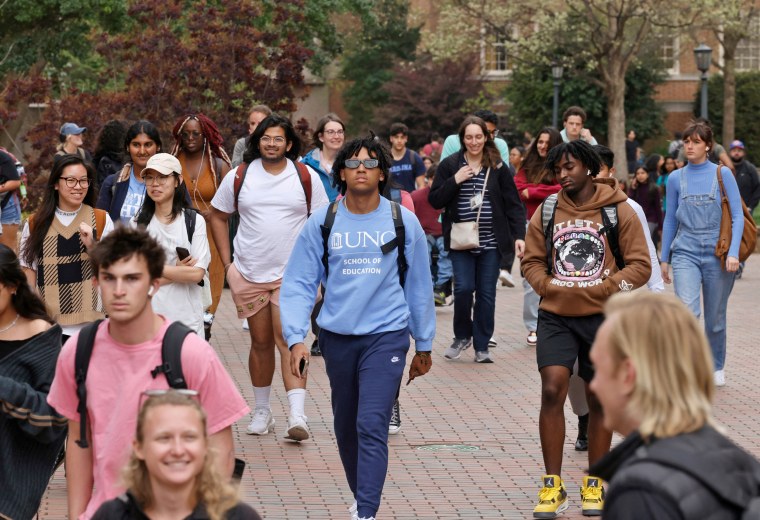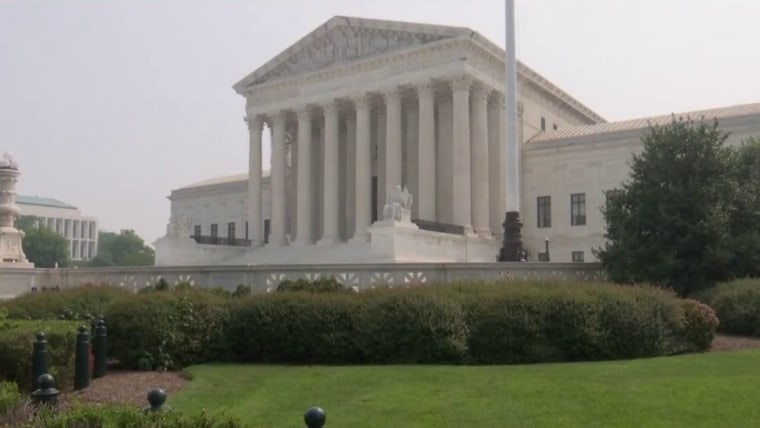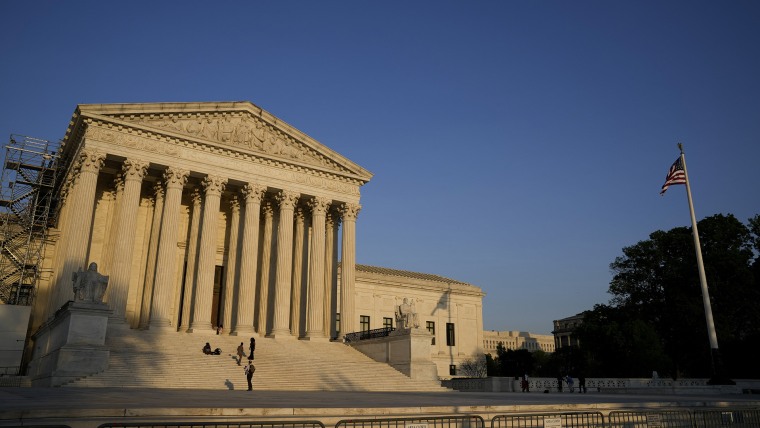Supreme Court strikes down college affirmative action programs
WASHINGTON — The Supreme Court on Thursday struck down affirmative action programs at the University of North Carolina and Harvard in a major victory for conservative activists, ending the systematic consideration of race in the admissions process.
The court ruled that both programs violate the Equal Protection Clause of the Constitution and are therefore unlawful. The vote was 6-3 in the UNC case and 6-2 in the Harvard case, in which liberal Justice Ketanji Brown Jackson was recused.
The decision was hailed by prominent conservatives, who say the Constitution should be “colorblind,” with former President Donald Trump calling it “a great day for America.” Liberals, however, condemned the ruling, saying affirmative action is a key tool for remedying historic race discrimination.
“It wasn’t perfect, but there’s no doubt that it helped offer new ladders of opportunity for those who, throughout our history, have too often been denied a chance to show how fast they can climb,” said Michelle Obama, the first Black first lady.
President Joe Biden called the decision a “severe disappointment,” adding that his administration would provide guidance about how colleges could maintain diversity without violating the ruling.

The court effectively overturned the 2003 ruling Grutter v. Bollinger, in which it said race could be considered as a factor in the admissions process because universities had a compelling interest in maintaining diverse campuses. In doing so, the court scrapped decades of precedent, including a ruling dating to 1978, that upheld a limited consideration of race in university admissions to combat historic discrimination against Black people and other minority groups.
In the majority opinion, Chief Justice John Roberts did not explicitly say the former precedents were overruled, but in a concurring opinion, conservative Justice Clarence Thomas, only the second Black justice to be appointed to the court, said the Grutter case was, “for all intents and purposes, overruled.”
Roberts wrote that both programs “lack sufficiently focused and measurable objectives warranting the use of race, unavoidably employ race in a negative manner, involve racial stereotyping, and lack meaningful end points.”
The ruling exposed stark divisions among the justices, who sit on a court that is more diverse than it has ever been.
Jackson, the first Black woman to serve on the court, wrote in a dissenting opinion that the ruling was “truly a tragedy for us all.”
Liberal Justice Sonia Sotomayor, the first Hispanic justice, wrote that the court “stands in the way and rolls back decades of precedent and momentous progress.”
Sotomayor, in a sign of her displeasure, read a lengthy summary of her dissenting opinion in the courtroom.
Thomas, a long-term critic of affirmative action, wrote his own 58-page opinion, in which he called the programs in question “rudderless, race-based preferences designed to ensure a particular racial mix in the entering classes.”
Both policies “fly in the face of our colorblind Constitution and our nation’s equality ideal,” he added.
Jackson stared straight ahead while Thomas read his opinion from the bench.
The ruling is another example in which the court, which has a 6-3 conservative majority, has delivered on the long-held goals of conservative legal activists. It follows the seismic ruling last year that overturned Roe v. Wade, the landmark 1973 decision that guaranteed a right to abortion.
The court’s decision is a major blow to the most selective universities, which say some consideration of race is vital in ensuring they have diverse student bodies.
The small number of schools that have extremely competitive admissions programs are the most affected. They have predicted that rulings against the colleges will lead to a significant drop in the enrollment of minority students and require admissions officers to experiment with new race-neutral plans to counteract the impact. The vast majority of colleges accept almost all applicants and will not be as affected.
Among the dozens of institutions that take race into account are Yale University, Brown University, Columbia University, the University of Pennsylvania, the University of Chicago and Dartmouth College.
Roberts left open the possibility of colleges’ considering the discussion of race in an individual student’s application, citing the example of someone who personally encountered racial discrimination.
The student “must be treated based on his or her experiences as an individual — not on the basis of race,” he added.
He also noted that the ruling does not address considering race in military academies. The Biden administration had warned that a ruling curbing affirmative action would detrimentally affect the U.S. military, which depends on a “well-qualified and diverse officer corps” educated at institutions like the U.S. Military Academy at West Point, as well as civilian universities.
It is unclear what flexibility colleges will have in adopting race-neutral programs to foster diverse student bodies. Those defending affirmative action said such policies will often fail, leading to declines in Black and Hispanic enrollments. The challengers point to examples in the nine states that already ban the practice as evidence that considering race is not essential.
The ruling is likely to have repercussions far beyond higher education, including on K-12 schools, and it puts increased pressure on colleges to come up with workable race-neutral programs that would foster racial diversity. The decision could also lead to future challenges to racial diversity programs used by employers, as similar arguments could be made under Title VII of the Civil Rights Act, which prohibits discrimination in employment.
In the 2003 ruling, Justice Sandra Day O’Connor wrote that affirmative action programs should no longer be needed by 2028.
Conservative Justice Brett Kavanaugh, in a concurring opinion, said that Thursday’s ruling would apply first to those starting college in 2028 and that the decision therefore did not conflict with the 2003 ruling.
Affirmative action, introduced to redress historic discrimination, has been a contentious issue for years, strongly supported by educational institutions and corporate America as being vital to fostering diversity and condemned by conservatives as being antithetical to the notion that racial equality means all races are treated the same.
Both challenges were brought by a group called Students for Fair Admissions, led by the conservative activist Ed Blum.
“The polarizing, stigmatizing and unfair jurisprudence that allowed colleges and universities to use a student’s race and ethnicity as a factor to admit or reject them has been overruled,” he said in a statement.
The legal debate that led to the latest ruling was left unresolved by a fractured 1978 Supreme Court ruling that prohibited racial quotas but left the door open to some consideration of race. That then led to the 2003 Grutter ruling, which again reluctantly allowed some affirmative action programs.
In 2016, the last time the Supreme Court ruled on affirmative action, the justices narrowly upheld the admissions policy at the University of Texas at Austin on a 4-3 vote, with conservative Justice Anthony Kennedy, who has since retired, casting the deciding vote.
The court shifted to the right after President Donald Trump appointed three conservative justices. President Joe Biden’s appointment of Jackson did not change the ideological balance of the court, as she replaced fellow liberal Justice Stephen Breyer. Because Jackson served on Harvard’s Board of Overseers during the litigation, she stepped aside from the Harvard case and participated only in the North Carolina dispute.
Blum’s group argued that any consideration of race in college admissions is unlawful under both Title VI and the Constitution. It said that the UNC admissions policy discriminates against white and Asian applicants and that the Harvard policy discriminates against Asians. In both cases, lower courts ruled in favor of the universities.
In defending their policies, the universities and their supporters — including the Biden administration, civil rights groups, businesses and former military leaders — argued that excluding someone based on race is completely different from seeking diversity on campus. The universities say race is just one factor that is considered as part of broad individualized analysis of each applicant.
UNC Chancellor Kevin Guskiewicz said the university “remains firmly committed to bringing together talented students with different perspectives and life experiences and continues to make an affordable, high-quality education accessible to the people of North Carolina and beyond.”
Harvard leaders issued a statement reaffirming their commitment to “the fundamental principle that deep and transformative teaching, learning and research depend upon a community comprising people of many backgrounds, perspectives and lived experiences.”
Harvard will now “determine how to preserve, consistent with the court’s new precedent, our essential values,” they added.



